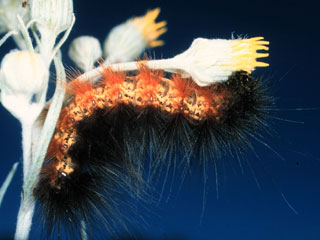
A tiger moth caterpillar feeding on a ragwort plant, which contains toxins that are especially tasty to parasitized caterpillars. Photo: Michael Singer/NATURESome parasites trigger their own destruction by altering their hosts' behavior, researchers at The University of Arizona and Wesleyan University report in Nature. Many parasites have developed mechanisms that suppress their hosts' ability to fight them off or even change their behavior in favor of the parasite. "We found the opposite is true with tiger moth caterpillars and their parasites," said UA Regents' Professor Emerita Elizabeth Bernays.
Bernays discovered the previously unknown phenomenon when she studied tiger moth caterpillars infected with parasitic fly larvae. The presence of the parasites alters their hosts' taste organs. As a result, the caterpillars prefer to consume plants containing chemicals toxic to the parasites.
Bernays, who is in the department of entomology at UA's College of Agriculture and Life Sciences and in the Division of Neurobiology at UA's Arizona Research Laboratories, did the research with Michael Singer, a former doctoral student of hers who is now an assistant professor in the department of biology at Wesleyan University in Middletown, Conn.
"It is a new and surprising kind of interaction between organisms," said Bernays. "When parasites change the behavior of their hosts, it's usually to their advantage."
The chemical war starts when parasitic flies of the tachinid family seek out their victims, the caterpillars of two species of tiger moth, Grammia geneura and Estigmene acrea. The flies lay their eggs on the outer surface (cuticle) of the caterpillar. As soon as the larvae hatch they bore through the cuticle and squeeze inside the caterpillar's body. Inside they feast on the caterpillar's tissue, using it as an ever-fresh live supply of food. When the fly larvae have eventually consumed and killed their host, they pupate and develop into adult flies.
But in the case of the tiger moth, co-evolution between parasite and host has resulted in an arms race involving chemical weapons.
Some plants that the caterpillars feed on produce chemicals that are toxic to the parasites and kill them. The chemicals, known as pyrrolizidine alkaloids and iridoid glycosides, are secondary compounds made by plants such as ragwort and plantain. When the caterpillars consume those plants, the substances become distributed throughout the caterpillar's body. The caterpillars store especially high amounts in their skin and blood to deter various natural enemies.
"Normally the caterpillars wander around and eat lots of different plants," explained Bernays.
But caterpillars with parasites in their bodies behave differently, the team found.
"They are likely to stay longer on those plants that contain the protective chemicals, thus eating more of the plants that are good for them," said Bernays.
Using neurophysiological methods, Bernays and Singer figured out why parasitized caterpillars switch to a more healthful eating behavior.
When parasites are present in a caterpillar, its taste cells react differently to chemicals in the food. The cells become more responsive to the protective chemicals and less sensitive to other chemicals, which are present in the same plants but are distasteful to the caterpillar and normally cause it to crawl off and look for tastier plants elsewhere.
As a result, the change in behavior elicited by the parasites makes parasitized caterpillars consume more of the beneficial plants. In many cases, the altered behavior helps the caterpillar to escape its impending doom because the plant chemicals kill off its parasites.
Bernays and her co-worker have not yet figured out by what mechanism the parasite elicits the change of behavior on a physiological level. "It's still a mystery how they do it," Bernays said. "But the result for the caterpillars is the same: They can survive because they find the protective plants more tasty."
Source : University of Arizona
 Print Article
Print Article Mail to a Friend
Mail to a Friend
